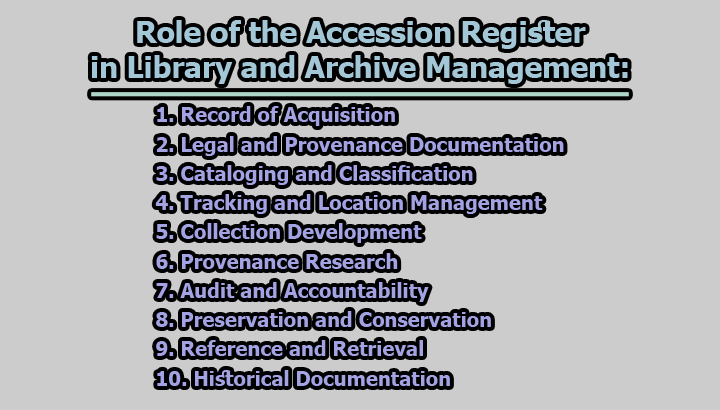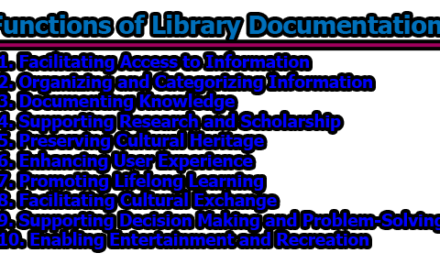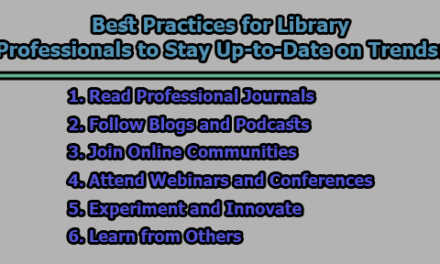Role of the Accession Register in Library and Archive Management:
The Accession Register plays a crucial role in the management of libraries and archives. It is a fundamental record-keeping tool that helps track and organize the acquisition of new materials, whether they are books, documents, manuscripts, or other types of resources. Here, we will provide a brief explanation of the role of the Accession Register in library and archive management:
1. Record of Acquisition: The Accession Register serves as a meticulous chronicle of the library or archive’s acquisitions, akin to a historian’s diary. It captures not just what was acquired but also when, creating a historical record of the collection’s growth. Each entry in the register is a unique historical artifact, marking the official initiation of an item into the institution’s curated treasures.
2. Legal and Provenance Documentation: Beyond its role as a mere recorder, the Accession Register is a guardian of legal and historical truths. It safeguards vital legal details, such as copyright agreements, rights, and donor restrictions, ensuring compliance with legal obligations. Provenance details recorded in the register provide an intimate glimpse into the item’s history. Like an ancient storyteller, it narrates the journey of the item through the hands of previous owners, collectors, and custodians.
3. Cataloging and Classification: The Accession Register is the cornerstone of systematic cataloging and classification. Each accession number acts as a primary key, connecting the item to a comprehensive bibliographic record. Catalogers and classifiers rely on the register to define an item’s identity within the library’s intricate web of knowledge, enhancing its discoverability.
4. Tracking and Location Management: Within the bustling corridors of the library or archive, the Accession Register assumes the role of a guiding star. It provides precise coordinates to locate materials efficiently, like a trusted map. The accession number, akin to a compass, guides staff in traversing the labyrinth of shelves, ensuring items are promptly retrieved for the benefit of eager patrons.
5. Collection Development: The Accession Register is the curator’s confidant, recording every decision made in the pursuit of knowledge. It reflects the institution’s evolving aspirations and priorities. It functions like a journal of institutional growth, revealing the choices made by generations of curators, reflecting the changing landscape of knowledge and societal needs.
6. Provenance Research: For scholars and researchers, the Accession Register is a treasure trove. It enables them to embark on historical expeditions, unearthing the hidden narratives of materials. It serves as the guidebook to understanding an item’s biography, shedding light on its connections to historical figures, events, and the broader cultural context.
7. Audit and Accountability: Beyond its academic contributions, the Accession Register is a sentinel of integrity. It stands as a testament to transparency, preserving the institution’s ethical commitment to responsible collection management. During audits and assessments, it serves as an unwavering reference point, validating the institution’s adherence to established policies and ethical standards.
8. Preservation and Conservation: The Accession Register is also a guardian of physical well-being. It captures vital information about the condition of items at the moment of acquisition, akin to a physician’s initial examination. These records are the cornerstone of preservation and conservation strategies, ensuring that items are protected and restored as needed to withstand the test of time.
9. Reference and Retrieval: Amid the bustling library or archive, the Accession Register is the navigator’s compass. It streamlines reference and retrieval efforts, enabling staff to embark on quests to locate treasures requested by users. With the accession number as their guide, staff navigate the collection like seasoned explorers, delivering knowledge to seekers with precision and speed.
10. Historical Documentation: As the years flow by, the Accession Register itself becomes a historical artifact, a testament to the institution’s journey through time. Its pages are imbued with the spirit of the ages. It is a mirror reflecting the growth and evolution of the collection, offering a window into the past for those who seek to understand the institution’s historical path and the choices that shaped its destiny.
In conclusion, the Accession Register is a foundational tool in library and archive management. It serves as a comprehensive record of acquisitions, helps with cataloging and classification, facilitates collection development decisions, aids in provenance research, supports preservation efforts, and ensures accountability in managing valuable cultural and informational resources. Properly maintained accession registers contribute to the effective organization and accessibility of collections for both current and future generations of users and researchers.
References:
- ALA Archives. (1995). “Accession Records.” American Library Association Archives.
- Kaplan, A. (2010). “Legal and Ethical Issues in the Acquisition of Manuscripts.” The American Archivist, 73(1), 163-182.
- Haycock, K., & Sheldon, B. (2008). “The Portable MLIS: Insights from the Experts.” ABC-CLIO.
- Gorman, M., & Miller, A. (2005). “Accessioning and Deaccessioning in Large Research Libraries: A Comparative Study.” Library Resources & Technical Services, 49(3), 168-177.
- Johnson, P. (2018). “Fundamentals of Collection Development and Management.” ALA Neal-Schuman.
- Pearce-Moses, R. (2018). “A Glossary of Archival and Records Terminology.” Society of American Archivists.
- National Archives and Records Administration (NARA). (2009). “Disposition of Federal Records: A Records Management Handbook.”
- Cunha, G. T., & Correa, E. R. (2011). “Preservation and Conservation of Library and Archival Materials.” Libraries Unlimited.
- (2002). “Cataloging Service Bulletin: Cataloging Electronic Resources.”
- Gorman, M., & Clayton, P. (2016). “Qualities of Quality: Understanding Excellence in Academic Libraries.” American Library Association.

Library Lecturer at Nurul Amin Degree College










